Advice for LONG summer X-country to Midwest
-
Members Online
- gabez
- BaldEagle
- BillC
- dkkim73
- Marc B
- exM20K
- Yan X
- TaildraggerPilot
- Hoeschen
- 825JH
- Mahsine Parthime
- warrenehc
- Marc_B
- Brian2034
- Sabremech
- Ragsf15e
- Fly Boomer
- 201Steve
- RonnieBurg
- Will.iam
- ResumeNormalSpeed83
- TCC
- 7.Mooney.Driver.0
- donkaye
- Bolter
- Igor_U
- Scooter
- RangerM20
- M20 Ogler
- Utah20Gflyer
- Geoaviator
- Jake@BevanAviation
- IvanP
- bigmo
- ElkoRandy20J
- DonMuncy
- wolfbyte
- Bartman
- Robm
- BrianL29
- Kelpro999
- spistora
- The Captain
- Justin Schmidt
- pirate
- MikeOH
- LardLad
- Rmfriday
- richardbrochu27
- PT20J


Recommended Posts
Join the conversation
You can post now and register later. If you have an account, sign in now to post with your account.